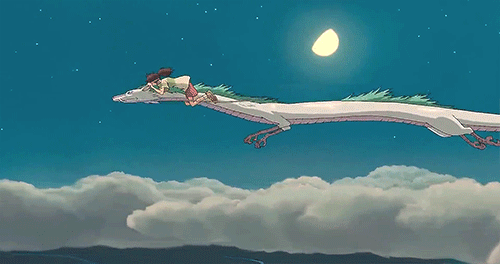Hayao Miyazaki
Hayao Miyazaki (1941-) a Japanese animator and the co-founder of Studio Ghibli.
The impact of Miyazaki's work is wide-ranging, reaching far beyond Japan and influencing generations of animators. Films like My Neighbour Totoro, Princess Mononoke and Spirited Away are increasingly being recognised as timeless classics in the same way that Disney's features have been for decades.


Spirited Away (2001)

My Neighbour Totoro (1988)

Miyazaki's films often feature a relationship with the natural world that can be lacking in our busy lives, offering memorable moments of peace and space. There is usually a blend of realistic landscapes and supernatural or mythical creatures, bringing fresh eyes to our connection with nature.
By drawing attention to land and water with convincing animation, Miyazaki introduces giants and monsters, which feel oddly at home in those environments, despite a strangeness to their appearance. It tends to be scenes moments of silence that resonate most with me, not always being entirely clear on what the beasts are thinking, if anything much.
It is not always the overall plot but instead the feeling of wonder that sticks in the memory. Many of Miyazaki's main protagonists are children, and this feels particularly appropriate, as we as the audience experience confusion, joy and fresh awe.
Ponyo (2008)
'Spirited Away': The Train Sequence
'Spirited Away' takes place within a spiritual world where the unknown rules can escalate the action to a chaotic energy. We see manic scenes of a giant violently vomiting, and hundreds of paper spirits attacking a dragon which crashes through a window. The film can be an uncomfortable watch, unpredictable and at times repulsive to look at. Perhaps that is what makes the train sequence by contrast particularly effective, as it creates a soothing quiet. At 1 hr 39 mins in, the scene lasts for just over two minutes and grants a sense of peaceful melancholy, with no dialogue to interrupt the slow journey.


It is a rare and special thing to see such a moment of stillness and unexplained mystery within a feature film of any kind, let alone an animated feature. The train sequence could almost be its own short film, working as a mood-piece, something of a living painting. We can interpret this as a version of the afterlife, with souls getting off the train to find their final resting place; yet none of this is explicitly stated. In fact, I tend to prefer stories which don't outright tell me a definite meaning. Images have their own power beyond words and logic. As I see the neon signs pass by the window of this one-way train to nowhere, I am reminded of how much image-making has a magic of its own, and whatever reason it can feel right.
"We never know where the story will go but we just keep working on the film as it develops".
Miyazaki's philosophy on the narrative of his films is to see what comes from the story-boarding process rather than a traditional screenplay. The resulting effect is a dreamy, meandering feel that always has the potential to surprise the viewer.
